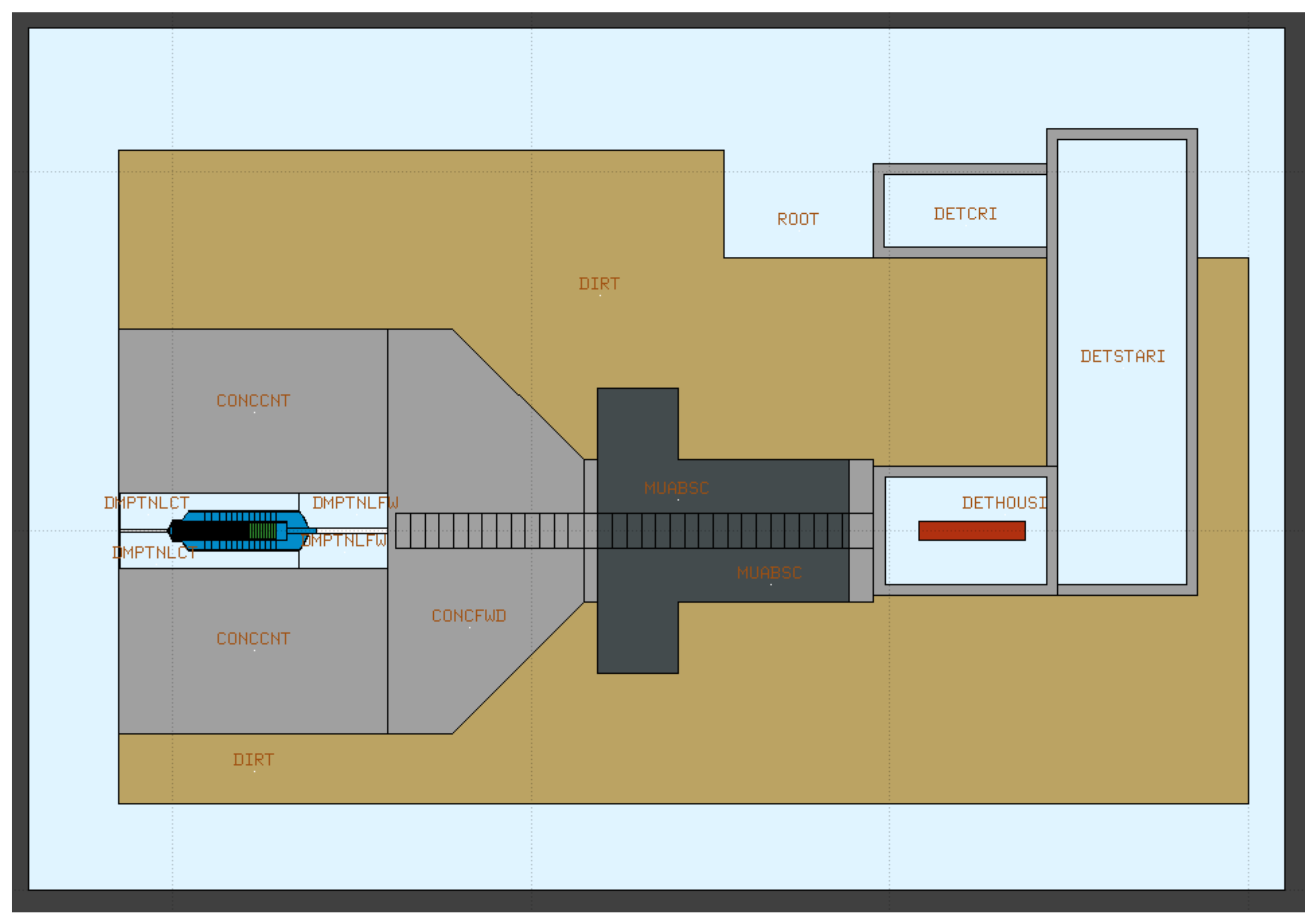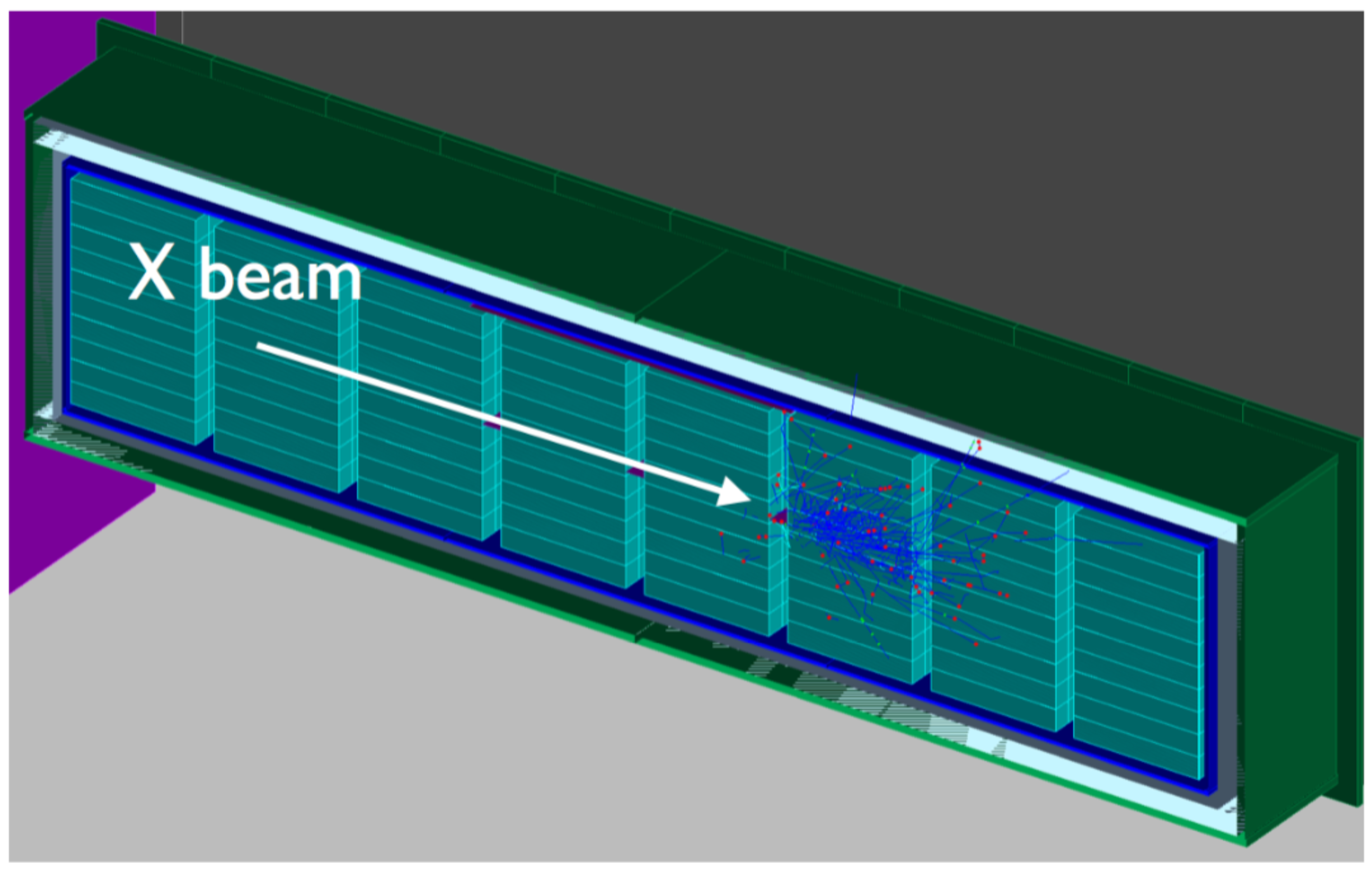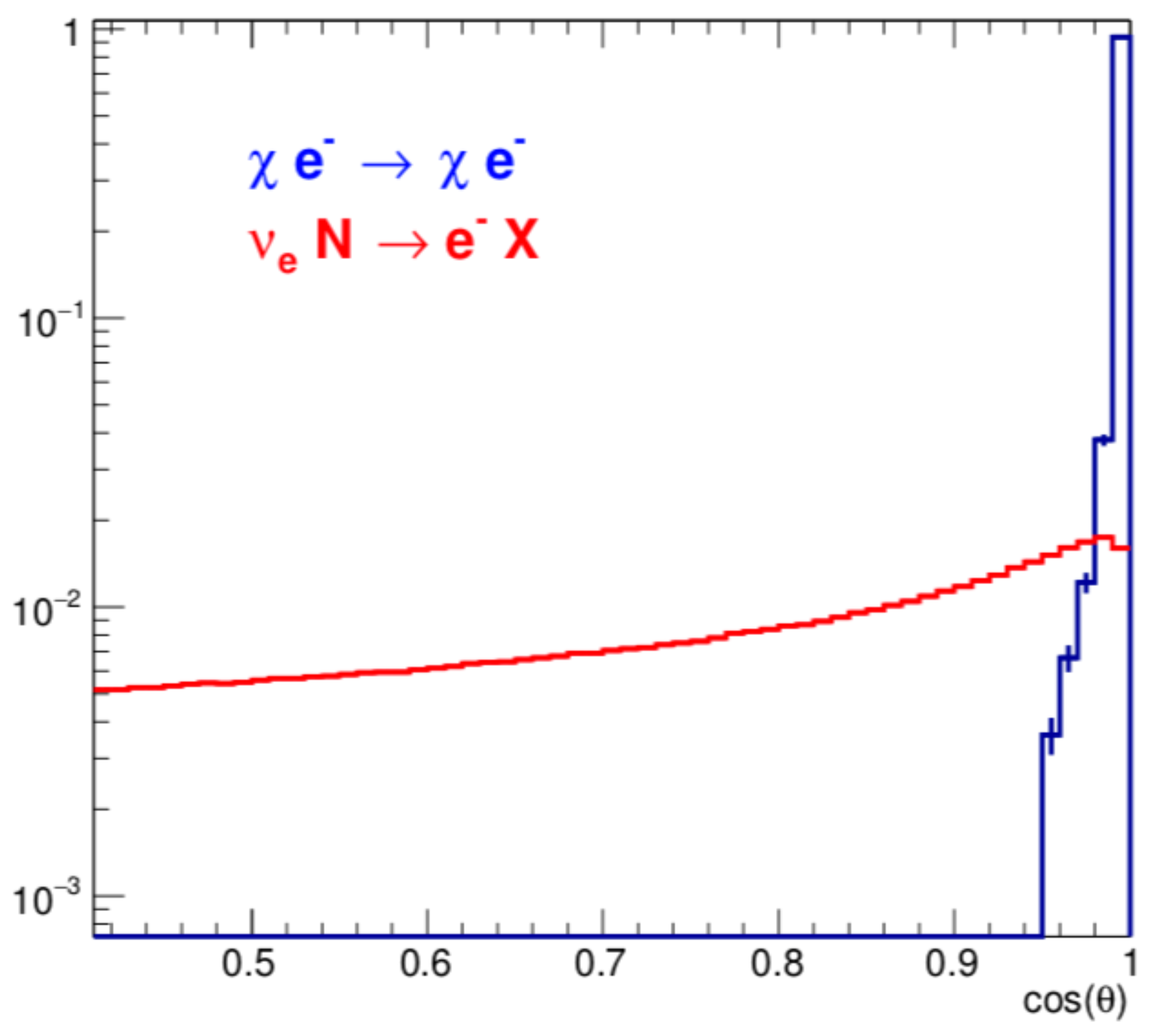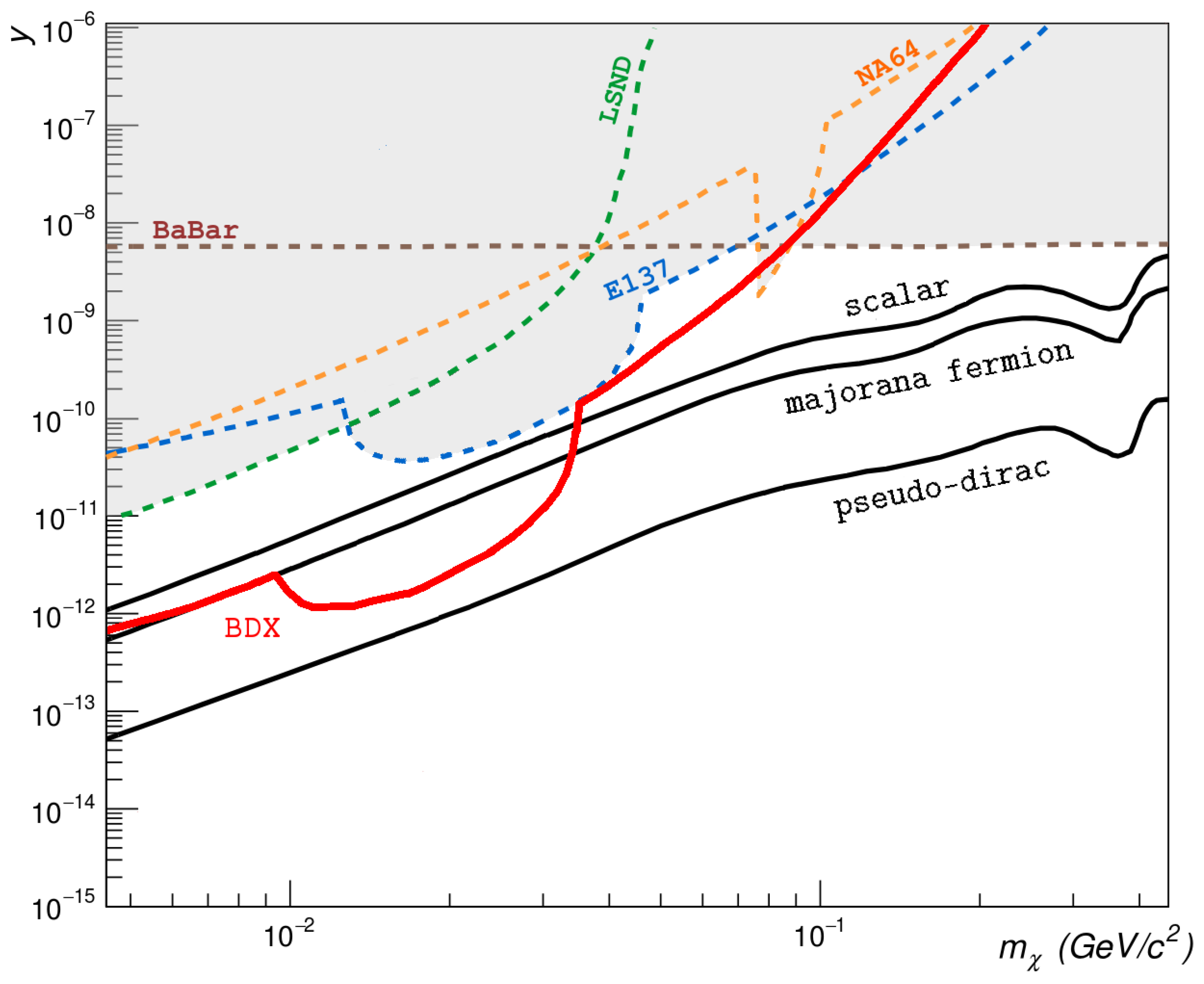Production and Detection of Light Dark Matter at Jefferson Lab: The BDX Experiment
Abstract
:1. Introduction
2. BDX Overview
3. The BDX Experimental Setup
4. Background
4.1. Beam-Related Background
4.2. Cosmogenic Background
5. Status and Perspectives
Funding
Conflicts of Interest
References
- Arcadi, G.; Dutra, M.; Ghosh, P.; Lindner, M.; Mambrini, Y.; Pierre, M.; Profumo, S.; Queiroz, F.S. The waning of the WIMP? A review of models, searches, and constraints. Eur. Phys. J. C 2018, 78, 203. [Google Scholar] [CrossRef]
- Battaglieri, M.; Belloni, A.; Chou, A.; Cushman, P.; Echenard, B.; Essig, R.; Estrada, J.; Feng, J.L.; Flaugher, B.; Fox, P.J.; et al. US Cosmic Visions: New Ideas in Dark Matter 2017: Community Report. arXiv 2017, arXiv:1707.04591. [Google Scholar]
- Holdom, B. Two U (1)’s and epsilon charge shifts. Phys. Lett. B 1986, 166, 196–198. [Google Scholar] [CrossRef]
- Essig, R.; Kaplan, J.; Schuster, P.; Toro, N. On the Origin of Light Dark Matter Species. arXiv 2010, arXiv:1004.0691. [Google Scholar]
- Aguila, F.D.; Coughlan, G.; Quirs, M. Gauge coupling renormalisation with several U(1) factors. Nucl. Phys. B 1988, 307, 633–648. [Google Scholar] [CrossRef]
- Arkani-Hamed, N.; Weiner, N. LHC signals for a SuperUnified theory of Dark Matter. J. High Energy Phys. 2008, 2008, 104. [Google Scholar] [CrossRef]
- Alexander, J.; Battaglieri, M.; Echenard, B.; Essig, R.; Graham, M.; Izaguirre, E.; Jaros, J.; Krnjaic, G.; Mardon, J.; Morrissey, D.; et al. Dark Sectors 2016 Workshop: Community Report. arXiv 2016, arXiv:1608.08632. [Google Scholar]
- Bjorken, J.D.; Essig, R.; Schuster, P.; Toro, N. New fixed-target experiments to search for dark gauge forces. Phys. Rev. D 2009, 80, 075018. [Google Scholar] [CrossRef]
- Andreas, S.; Niebuhr, C.; Ringwald, A. New limits on hidden photons from past electron beam dumps. Phys. Rev. D 2012, 86, 095019. [Google Scholar] [CrossRef]
- Izaguirre, E.; Krnjaic, G.; Schuster, P.; Toro, N. New electron beam-dump experiments to search for MeV to few-GeV dark matter. Phys. Rev. D 2013, 88, 114015. [Google Scholar] [CrossRef]
- Battaglieri, M.; Bersani, A.; Caiffi, B.; Celentano, A.; De Vita, R.; Fanchini, E.; Marsicano, L.; Musico, P.; Osipenko, M.; Panza, F.; et al. [BDX Collaboration]. Dark matter search in a Beam-Dump eXperiment (BDX) at Jefferson Lab. arXiv 2016, arXiv:1607.01390. [Google Scholar]
- Bondí, M. [BDX Collaboration]. Light Dark Matter search in a beam-dump experiment: BDX at Jefferson Lab. Eur. Phys. J. Web Conf. 2017, 142, 01005. [Google Scholar] [CrossRef]
- Marsicano, L.; Battaglieri, M.; Bondí, M.; Carvajal, C.D.R.; Celentano, A.; De Napoli, M.; De Vita, R.; Nardi, E.; Raggi, M.; Valente, P. Dark photon production through positron annihilation in beam-dump experiments. Phys. Rev. D 2018, 98, 015031. [Google Scholar] [CrossRef]
- Marsicano, L.; Battaglieri, M.; Bondí, M.; Carvajal, C.D.R.; Celentano, A.; De Napoli, M.; De Vita, R.; Nardi, E.; Raggi, M.; Valente, P. Novel Way to Search for Light Dark Matter in Lepton Beam-Dump Experiments. Phys. Rev. Lett. 2018, 121, 041802. [Google Scholar] [CrossRef] [PubMed]
- Böhlen, T.T.; Cerutt, F.; Chin, M.P.W.; Fassò, A.; Ferrari, A.; Ortega, P.G.; Mairani, A.; Sala, P.R.; Smirnov, G.; Vlachoudis, V. The FLUKA Code: Developments and Challenges for High Energy and Medical Applications. Nucl. Data Sheets 2014, 120, 211–214. [Google Scholar] [CrossRef]
- Bondí, M.; Battaglieri, M.; Carpinelli, M.; Celentano, A.; De Napoli, M.; De Vita, R.; Marsicano, L.; Randazzo, N.; Sipala, V.; Smith, S.S. Large-size CsI(Tl) crystal read-out by SiPM for low-energy charged-particles detection. Nucl. Instrum. Methods A 2017, 867, 148–153. [Google Scholar] [CrossRef]
- Ameli, F.; Battaglieri, M.; Bondì, M.; Capodiferro, M.; Celentano, A.; Chiarusi, T.; Chiodi, G.; De Napoli, M.; Lunadei, R.; Marsicano, L.; et al. A low cost, high speed, multichannel analog to digital converter board. Nucl. Instrum. Methods A 2019, in press. [Google Scholar] [CrossRef]
- Agostinelli, S.; Allison, J.; Amako, K.; Apostolakis, J.; Araujo, H.; Arce, P.; Asai, M.; Axen, D.; Banerjee, S.; Barrand, G.; et al. Geant4—A simulation toolkit. Nucl. Instrum. Methods A 2003, 506, 250–303. [Google Scholar] [CrossRef]
- Battaglieri, M.; Bersani, A.; Bracco, G.; Caiffi, B.; Celentano, A.; De Vita, R.; Marsicano, L.; Musico, P.; Osipenko, M.; Panza, F.; et al. [BDX Collaboration]. Dark matter search in a Beam-Dump eXperiment (BDX) at Jefferson Lab: an update on PR12-16-001. arXiv 2017, arXiv:1712.01518v2. [Google Scholar]
- Battaglieri, M.; Bersani, A.; Bracco, G.; Caiffi, B.; Celentano, A.; De Vitay, R.; Marsicano, L.; Musico, P.; Panza, F.; Ripani, M.; et al. [BDX Collaboration]. Dark Matter Search in a Beam-Dump eXperiments (BDX) at Jefferson Lab–2018 Update to PR12-16-001. Available online: https://www.jlab.org/exp_prog/proposals/18/C12-16-001.pdf (accessed on 1 June 2018).
- Battaglieri, M.; Bondí, M.; Celentano, A.; De Napoli, M.; De Vita, R.; Fegan, S.; Marsicano, L.; Ottonello, G.; Parodi, F.; Randazzo, N.; et al. Measurements of the muon flux produced by 10.6 GeV electrons in a beam dump. Nucl. Instrum. Methods A 2019, 925, 116–122. [Google Scholar] [CrossRef]






© 2019 by the author. Licensee MDPI, Basel, Switzerland. This article is an open access article distributed under the terms and conditions of the Creative Commons Attribution (CC BY) license (http://creativecommons.org/licenses/by/4.0/).
Share and Cite
De Napoli, M. Production and Detection of Light Dark Matter at Jefferson Lab: The BDX Experiment. Universe 2019, 5, 120. https://doi.org/10.3390/universe5050120
De Napoli M. Production and Detection of Light Dark Matter at Jefferson Lab: The BDX Experiment. Universe. 2019; 5(5):120. https://doi.org/10.3390/universe5050120
Chicago/Turabian StyleDe Napoli, Marzio. 2019. "Production and Detection of Light Dark Matter at Jefferson Lab: The BDX Experiment" Universe 5, no. 5: 120. https://doi.org/10.3390/universe5050120
APA StyleDe Napoli, M. (2019). Production and Detection of Light Dark Matter at Jefferson Lab: The BDX Experiment. Universe, 5(5), 120. https://doi.org/10.3390/universe5050120




